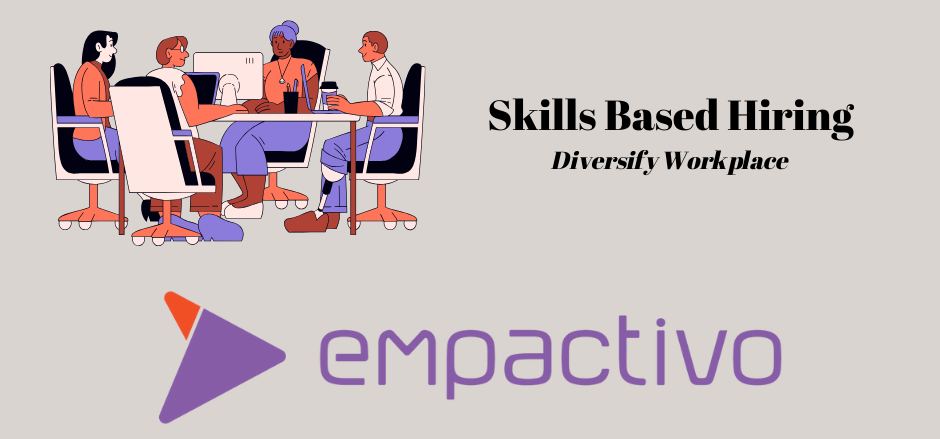Today we will talk about skills based hiring. When it comes to recruiting new employees, very few businesses are immune to making a mistake. In fact, a lot of HR managers have been through a failed hiring process. For a lot of firms, this may be a huge setback, particularly in industries where trends come and go at a quick pace. In fact, depending on the degree of roles involved, a poor recruiting might cost to companies.
Entering to Skills Based Hiring
In order to keep fresh talent from jumping ship too soon and stunt their company’s development, recruitment managers must immediately vary their practices.
Here is where skills based hiring, a more modern approach to hiring, comes into its own. This approach, which has been evolving in world for a while and goes by terms like “skills based hiring” and “recruitment by skills,” is producing results on many of fronts.
The purpose of this blogpost is to outline skills based hiring, describe its many advantages, and then provide some recommendations for implementing this novel approach, after which it will highlight the limits of standard recruitment techniques.

Traditional Recruiting Methods: Strengths and Weaknesses
The HR department is known for its adherence to more conventional practices. Actually, they care more about things that have nothing to do with a candidate’s abilities when hiring. Traditional selection factors, such as being a graduate of an elite school or having worked for a well-known company, are sometimes given more weight than more modern ones.
Even while this method of hiring is commonplace worldwide, it has major flaws that may hurt businesses. Indeed, hiring practices that prioritize a candidate’s academic credentials, work experience, and certifications above their practical abilities miss out on a significant portion of their potential.
Weaknesses of Tradinitional Methods
- Disruption of Fair Opportunities
Unfortunately, recruiting teams undermine selection fairness and, by extension, equal opportunity, when they provide preferential treatment to candidates with degrees from elite Parisian institutions or who have acquired prominent credentials, even when other candidates are just as qualified.
- Teams Becoming More Similar
It’s sad that HR is not immune to prejudices in hiring. Team homogeneity and a lack of variety in thinking are consequences of using traditional approaches that favor profiles from comparable social, cultural, and economic backgrounds.
- Talent Dwindle
If a candidate has a strong work history or has had a prominent position at a well-known organization, it could be difficult to tell what their technical abilities and “soft skills” are. Reason being, these kinds of abilities aren’t often the most obvious on a resume. As a result, businesses risk losing out on talented individuals whose unique character traits or skill sets may have boosted the team’s performance.

Talent acquisition is being transformed by competency-based recruiting.
A definition of competency-based recruiting is necessary for a complete understanding of its advantages.
The emphasis on competency-based recruiting is on applicants’ practical experience, expertise, and character traits rather than their academic background, in contrast to the more traditional approach. Companies can make sure they are hiring the proper people by looking for qualities including technical expertise, problem-solving ability, emotional intelligence, and logical thinking.
This approach alters the playing field in a dynamic setting. New occupations that didn’t exist ten years ago are cropping up, and the variety of jobs available is expanding. Consequently, finding people with the skills necessary to adapt to these new circumstances requires competency-based recruiting.
Ten advantages of a method that is built on competencies are below. Enjoy reading!
Why Skills Based Hiring?
- Broaden talent pool: Recruiting based on talents increases the pool of possible applicants by taking into account additional profiles.
Second, employing based on skills helps cut down on casting mistakes and the associated financial losses by improving decision-making throughout the recruiting process. - Enhance knowledge of requirements: This approach to recruiting necessitates a more detailed introspective examination of the abilities the organization requires, compelling it to hone its self-awareness.
- Find the right person for the job: This tactic calls for better competence testing, which in turn leads to a successful hiring process.
- Keep talent: Hiring the right individual for the job boosts talent’s professional happiness, which keeps them motivated and engaged in the long run.
Improvements in performance and output are associated with higher levels of work satisfaction, which brings us to point number six: increasing productivity. - Promote diversity: Organizations may promote diversity in the workplace by lowering hiring obstacles and hiring individuals with varied backgrounds and experiences.
- Foster creativity and adaptation: By capitalizing on the great range of expertise and character traits present in the organization possible to create a creative and adaptive atmosphere at workplace.
- Reinforce business culture: Competency-based HR teams bring attention to shared values and prioritize employee compatibility, which in turn strengthens the firm’s culture.
- Make sure the company can keep running: Companies may secure their future by anticipating their demands and differentiating themselves from competitors by building a strong talent pool.
To sum up, the short-term gains from competency-based recruiting are insufficient to justify the practice. They will be able to adapt to changes and meet the new requirements of future with benefits that help to competitiveness and the life of organizations.
Summary
Every company has what it takes to implement a competency-based recruiting strategy. Companies should update their job postings to highlight necessary skills and responsibilities, diversify talent acquisition channels to reach non-traditional candidates, define selection criteria to avoid bias in recruiting by focusing on skills, and use competency tests to consistently evaluate candidates. This will help them transition towards the future of recruitment.
